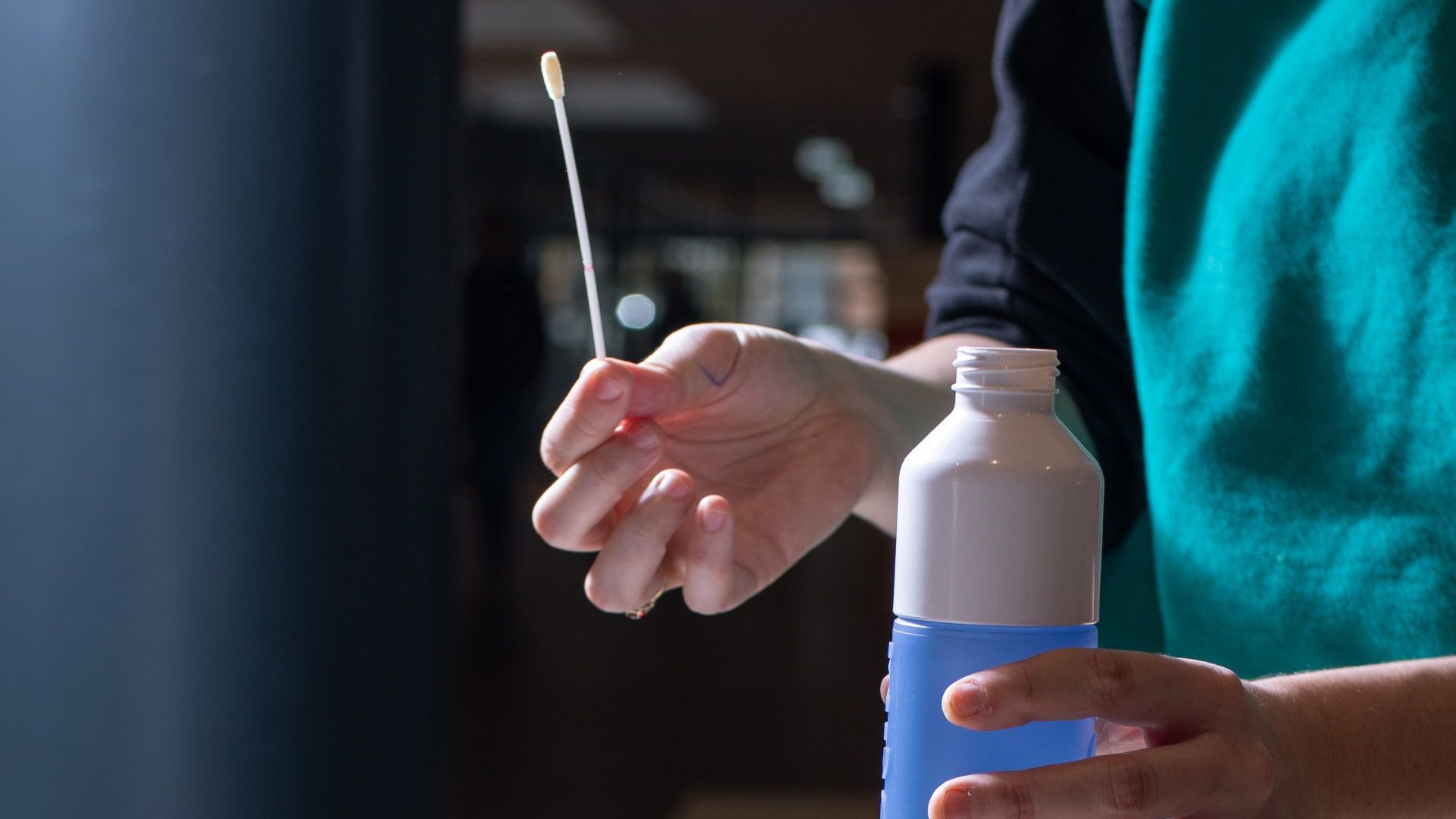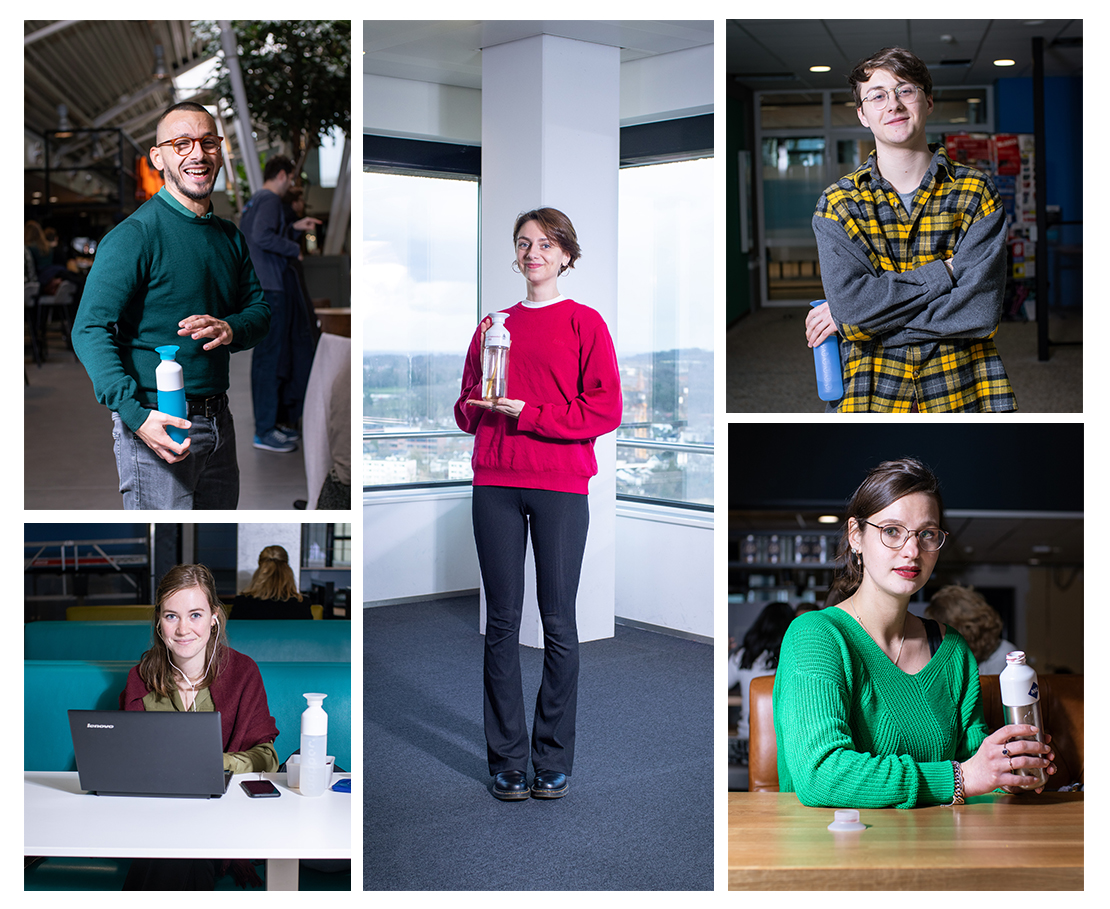Poo bacteria in your Dopper
-
 Photo: Rein Wieringa
Photo: Rein Wieringa
We all know we should wash our water bottles on a regular basis. But who actually does that? After reading this article, chances are you’ll be much more motivated to grab that washing-up brush. After all, who wants intestinal bacteria in their Dopper?
They are everywhere. Dangling from the hands of students on their way to the lecture hall, glued to the mouths of sweaty sports centre visitors, on office desks next to the sandwiches brought in from home. The Dopper. Jokingly called ‘the cigarette of 2019’ by Assistant Professor Lucienne van der Geld in a recent Vox column.
The Haarlem company that produces and sells ever-increasing numbers of Dopper bottles sometimes get complaints about bottles ‘smelling like my grand-mother’s attic’, as can be read on their website. Many people are apparently under the illusion that a water bottle contains only water. You just rinse it and you’re good to go. The occasional unpleasant smell can be eradicated with a bit of washing-up liquid. But what if we take a closer look, and submit five random Dopper bottles to a bacteriological test? Vox carried out a sample test on Campus.
Cotton swabs
‘This will be my urn one day.’ Bas Nietsch (20), student of English Language and Culture, laughs as he casually tosses his beloved lightblue Dopper in the air. He’s had it for seven years. Nietsch’ mother had had enough of continuously buying water bottles, he explains.
‘One day she came home with this Dopper.’ Nietsch bangs the bottle down on the table. ‘ “Here you go”, she said.’ How well does Nietsch treat his future funeral urn? He washes it every week using water and washing-up liquid, he explains. OK, sometimes every two weeks. He thinks that’s good enough.
‘Water that contains these kinds of bacteria is not safe for consumption’
Davide Cellamare (34), Postdoc in History of Philosophy, bought his azure blue Dopper last September – before that he simply drank water from a glass. Three times a week he washes the bottle in the dishwasher. ‘I really should do it every day,’ he says.
Communication Science student Nikki de Nies (26) aims to clean her Dopper thoroughly once a week. She even bought a special chemical to keep her steel edition super clean. ‘But I do sometimes forget,’ she admits.

Nietsch, Cellamare and Nies all three agree to have their Dopper swabbed. Two other Dopper users spontaneously volunteer their bottles. A cotton swab is run along the outside and the inside of the mouthpiece. The swabs are then put into special test tubes and are sent by post to the Canisius-Wilhelmina Hospital laboratory, where Microbiology Analyst Maayke Bohne grows her cultures. Within a few days we find out what grows and flourishes in the five Dopper bottles.
Slime
‘I’m actually really impressed,’ says Physician- Microbiologist Andreas Voss after studying the result. He runs us through the cultures identified by Bohne and her lab. Some of the flora on the petri dishes were to be expected, says Voss. ‘You drink from a Dopper and you touch it, so I assumed we would find throat, mouth and skin flora.’ And in fact, this was the case in all the bottles.
Two of the bottles studied only contained skin and mouth flora; the others contained more life forms. For example, to his surprise, Voss found large numbers of non-fermenters. ‘These microorganisms thrive in humid conditions and occur naturally in water,’ he says. But they don’t appear in such numbers in tap water. One of the Dopper bottles contained not only large quantities, but also a great variety of non-fermenters.
Cleaning tips
1. Wash your bottle every day; hot water is usually enough.
2. Let the Dopper dry completely. Don’t refill it immediately – especially if you don’t use a dishwasher that washes and dries it. Voss: ‘This is the only way to kill bacteria that like humid environments.’
3. For the absolutely risk-averse: stick to your own Dopper, and don’t drink from other people’s bottles.
Biofilm
‘Maybe this Dopper bottle is lined with a thick layer of biofilm,’ says Voss. A biofilm is a layer of microorganisms, surrounded by self-produced slime. ‘I can’t be sure, we would have to test the water too,’ explains the microbiologist. ‘Either way, the owner should probably switch to another Dopper bottle, or at least clean it more thoroughly.’
The same Dopper also contains Staphylococcus aureus, a pathogen. ‘Approximately 20% of all people carry this microorganism in their throat and nose,’ he says. ‘The owner of this Dopper might well be a carrier. I wouldn’t want to drink from this bottle. Especially because of the biofilm, I wouldn’t recommend sharing this bottle with others.’ However, the pathogen is nothing compared to what Voss finds in one of the other bottles: various kinds of Enterobacter cloacae, intestinal bacteria. Voss: ‘These bacteria should never be present in drinking water. Water that contains these kinds of bacteria is not safe for consumption.’

Disgusting
Poo bacteria and a thick biofilm: it sounds pretty disgusting, but are all these bacteria actually dangerous? ‘No,’ says Voss. Even the intestinal bacteria are unlikely to make people ill. And in most cases, the organisms on a Dopper come from the users themselves. People contaminate their own Dopper by drinking from it.
‘Ugh,’ says student Nikki de Nies when she hears about the organisms found on the Doppers. She’s not really surprised: when she’s in a hurry – which is often – she doesn’t wait for her Dopper to dry properly. After all, it makes little sense to dry the bottle with a tea towel if you’re going to refill it anyway. Nies: ‘I’m a bit chaotic.’ She resolves to be more thorough when cleaning her bottle. ‘Now let’s just hope I keep this up.



